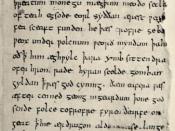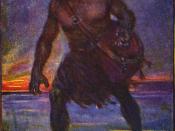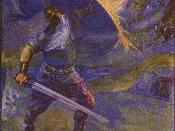William Butler Yeats stated that "Supreme art is a traditional statement of certain heroic and religious truths, passed on from age to age..." which definitely refers to Anglo-Saxon literature. Stories that have been handed down through the generations were written down and reworked by monks adding religious beliefs. These stories of the Anglo-Saxon literature contain heroic ideals and the traditions of the older Anglo-Saxon religion. "Beowulf", the first great work of a national literature, tells of a hero's quest over evil along with the Christian elements in the epic. In the epic poem "Beowulf", the monks mix the warrior and heroic traits with the religious faith of Christians.
In the epic Beowulf, there is a mix of ideas containing heroic and religious truths. Beowulf is a noble, heroic warrior who isn't afraid of anything and will stare evil in the eye. When Beowulf fights Grendel, he has so much faith in the strength God has given him that he uses no weapons or armor.
The following statement exhibits the strength of Beowulf, "That shepherd of evil, guardian of crime, knew at once that nowhere on earth had he met a man whose hands were harder..." (Lines 432-434). Beowulf kills Grendel with his bare hands by ripping off his arm and raising it high in the mead-hall of Herot. Beowulf is the perfect example of a hero who has superhuman strength as well as a God that will remain by his side and protect him from all forms of evil. During the battle with Grendel, Beowulf is positive that he will defeat Grendel with his strength and the guidance of God, and Beowulf never doubts his strength and knows that he will be victorious.
After Beowulf slays Grendel, Grendel's mother attacks the kingdom trying to obtain revenge for the death...


